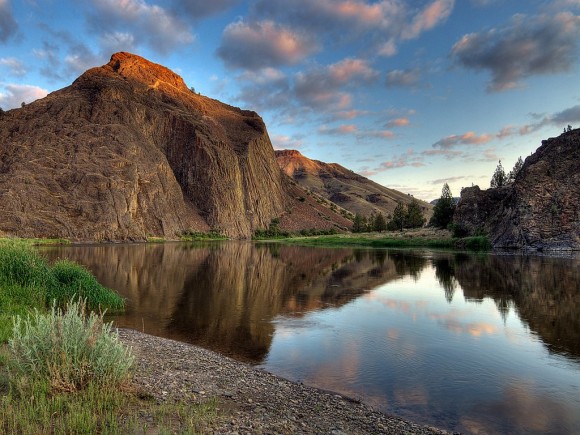
Oregon is a Desert State
by: Oregon Natural Desert Association: Brent Fenty Posted on: April 06, 2012
Photo: Greg Burke
By Brent Fenty, Executive Director of the Oregon Natural Desert Association (ONDA)
Editor’s Note: Take it from Brent, the Executive Director of the Oregon Natural Desert Association: as we work to protect more land, we can’t forget about the deserts.
Typically when people think of Oregon wilderness, they think of old growth forests and wild untamed coastal beauty. However, half of Oregon is high desert, and this incredible area is largely unknown – even to most Oregonians.
This fact is a major reason why Oregon has only protected 4% of its wilderness lands, less than half or even a third of what neighboring states like Washington (10%), California (15%) and Idaho (9%) have protected. This is, of course, not for lack of incredible lands and rivers that make Oregon so unique. It is largely due to the fact that Oregon has yet to permanently protect even a fraction of its desert lands. In Oregon, approximately 2.2 million acres or nearly 7% of our forests have been designated as Wilderness – certainly not enough, but at least a step in the right direction. In contrast, a meager 200,000 acres, or less than 1%, of Oregon’s high desert is currently protected as Wilderness despite the fact that this ecosystem covers half the state.
Interestingly, by the federal government’s own admission, there are nearly three million acres of Oregon desert lands that qualify as Wilderness and have been managed as “Wilderness Study Areas” for nearly three decades (it’s worth noting that citizen-led wilderness inventories have found that there are actually nearly eight million acres of potential Wilderness in Oregon’s high desert). The protection of just the federally-designated “Wilderness Study Areas” would increase Oregon’s wilderness percentage to 9% and bring the Desert State, sometimes referred to as the Beaver State, in line with our Washington and Idaho neighbors.
The Oregon Natural Desert Association (ONDA) exists to fulfill this dream. ONDA remains the only group dedicated exclusively to protecting and restoring Oregon’s high desert. Founded in 1987, ONDA boasts over 4,000 members and supporters.
Over the years, ONDA has earned many successes, including the recent protection of Oregon’s Badlands and Spring Basin as the state’s second and third desert Wilderness areas. Badlands and Spring Basin were both established by the federal Omnibus Public Land Management Act of 2009. ONDA was also instrumental in the creation of Steens Mountain Wilderness in 2000 and has worked hard over the past 25 years to address threats to wildlife and wildlands from impacts such as energy development, livestock grazing and off-road vehicle use.
An active volunteer network not only helped ONDA protect these key areas but has also led to the restoration of fish and wildlife havens such as Hart Mountain and the John Day River. Hard-working volunteers have planted thousands for trees, restored dozens of miles of streams, decommissioned old roads and removed enough barbed wire to stretch from one end of Oregon to the other. The removal of this barbed wire fence is critical to restoring habitat for species like the sage grouse and pronghorn. The pronghorn antelope, for example, is North America’s fastest land mammal. Approaching speeds of 60 miles per hour, an unseen fence can be a rude awakening and is one contributing factor to the long-term decline in pronghorn populations across the West. Thanks to hardworking volunteers, wildlife like pronghorn can roam more freely.
In its 25th year, ONDA is working to ensure that the wilderness gap between Oregon and our neighbors is shrinking. We are actively promoting wilderness campaigns across eastern Oregon. In the John Day Basin region, the Cathedral Rock and Horse Heaven proposed Wilderness areas (pictured above) total nearly 18,000 acres.
This proposal was introduced as legislation by Senators Wyden and Merkley and is currently awaiting mark-up in the US Senate. ONDA is also crafting wilderness proposals encompassing 100,000 additional acres in nearby areas. The Central Oregon Wilderness campaign is building the local support for two wilderness proposals to protect over 150,000 acres of high desert near the town of Bend.
At over 2 million acres and located in the far southeast corner of the state, Oregon’s Owyhee Canyonlands region is the largest expanse of undeveloped and unprotected wildlands in the lower 48 states and represents an incredible opportunity for American conservation.
Collectively, these lands are emblematic of Oregon’s pristine beauty and essential to the survival of native wildlife. The permanent protection of these lands would also double the amount of Wilderness in the State of Oregon and serve as a permanent reminder to Oregonians that we live in a Desert State.
3 Responses to “Oregon is a Desert State”
Articles On Flora
Flora: Flora
- Apr 1 Big or Small: Who Will Grow Washington’s Cannabis Crop?
- Jul 19 A Case to Protect Public Land
- Apr 6 Oregon is a Desert State
- Dec 14 Forest Protection-The Olympic Peninsula
- Nov 30 Keeping Working Forests on the Landscape
- Nov 2 It’s a Wild Life – Can You Spare Some Passion?
- Sep 28 West Hylebos Wetlands: A Place Worth Preserving
- Aug 8 12,000 Rain Gardens
- Jul 11 Investing in Seed Banks
- Oct 21 Native Plant Spotlight: Oregon Grape
- Oct 21 Washington’s Roadless Forests


by: Dan Van Vactoron: Sunday 8th of April 2012
by: Georgia Laramoreon: Thursday 18th of October 2012
by: Lukason: Friday 13th of June 2014